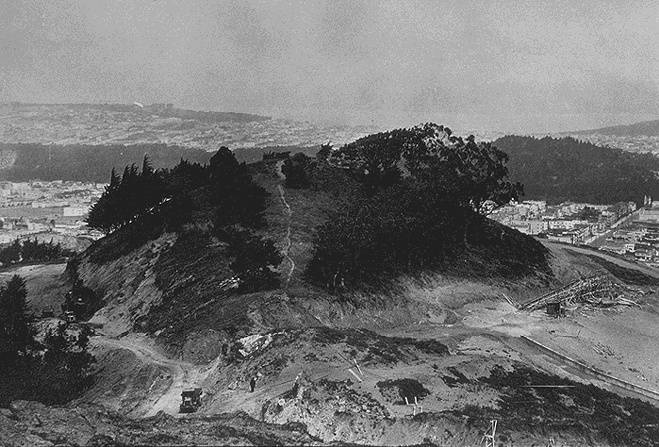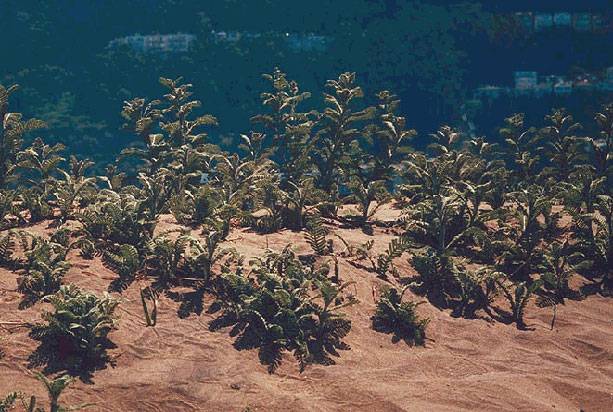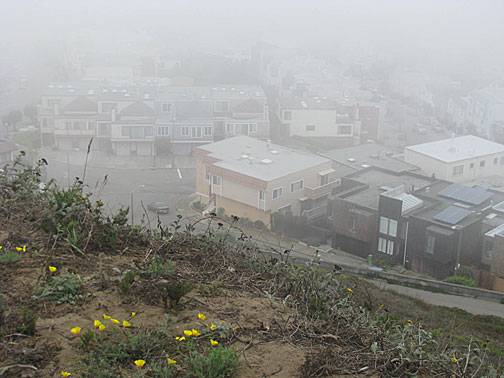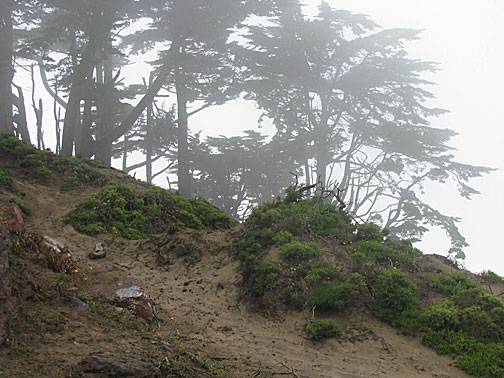Grandview Park: Difference between revisions
No edit summary |
added image of lupine |
||
| (5 intermediate revisions by 2 users not shown) | |||
| Line 1: | Line 1: | ||
'''<font face = Papyrus> <font color = maroon> <font size = 4>Historical Essays</font></font> </font>''' | |||
''Part one by Pete Holloran'' | |||
''Part two by Harold Gilliam'' | |||
[[Image:sunset$grand-view-peak-road-building.jpg]] | [[Image:sunset$grand-view-peak-road-building.jpg]] | ||
'''Grand View Peak being graded in the late 1920s.''' | '''Grand View Peak being graded in the late 1920s.''' | ||
''Photo: | ''Photo: Private Collection, San Francisco, CA'' | ||
The commanding views of northwest San Francisco are worth the steep climb up from the streets below. The red bedrock of this outcrop is visible only at the top where decades of visitors--especially on the fourth of July--have trampled the vegetation that kept its sandy cover in place. Great dunes climbed up and over the 700-foot hilltop on their way from Ocean Beach towards downtown. | The commanding views of northwest San Francisco are worth the steep climb up from the streets below. The red bedrock of this outcrop is visible only at the top where decades of visitors--especially on the fourth of July--have trampled the vegetation that kept its sandy cover in place. Great dunes climbed up and over the 700-foot hilltop on their way from Ocean Beach towards downtown. | ||
| Line 46: | Line 52: | ||
Now you can begin to see the bright gold of California poppies to be followed in turn by blue lupine and then by the spectacular tree lupine with its immense stalks of yellow bloom. Later will come goldenrod, Indian paintbrush and dozens of other varieties, spreading color down these slopes. | Now you can begin to see the bright gold of California poppies to be followed in turn by blue lupine and then by the spectacular tree lupine with its immense stalks of yellow bloom. Later will come goldenrod, Indian paintbrush and dozens of other varieties, spreading color down these slopes. | ||
[[Image:Silver-lupine 6648.jpg]] | |||
'''Bright purple blooms from silver lupine, seen here on Twin Peaks in 2010.''' | |||
''Photo: Chris Carlsson'' | |||
Wildlife driven from other areas by the advance of the sub-divisions has found refuge here and on the slopes below. Often in early morning you can see intricate tracings on the damp sand, indicating the presence of small animals. The mellifluous meadowlarks, almost unknown elsewhere in the city, can be heard here. | Wildlife driven from other areas by the advance of the sub-divisions has found refuge here and on the slopes below. Often in early morning you can see intricate tracings on the damp sand, indicating the presence of small animals. The mellifluous meadowlarks, almost unknown elsewhere in the city, can be heard here. | ||
| Line 87: | Line 99: | ||
''Photo: Chris Carlsson'' | ''Photo: Chris Carlsson'' | ||
[[Grand View Park photos |Prev. Document]] [[ | [[Grand View Park photos |Prev. Document]] [[Growing up in Golden Gate Heights |Next Document]] | ||
[[category:Sunset]] [[category:1920s]] [[category:1960s]] [[category:Ecology]] [[category:habitat]] [[category:2000s]] | [[category:Sunset]] [[category:1920s]] [[category:1960s]] [[category:Ecology]] [[category:habitat]] [[category:2000s]] [[category:West of Twin Peaks]] | ||
Latest revision as of 23:21, 20 January 2017
Historical Essays
Part one by Pete Holloran
Part two by Harold Gilliam
Grand View Peak being graded in the late 1920s.
Photo: Private Collection, San Francisco, CA
The commanding views of northwest San Francisco are worth the steep climb up from the streets below. The red bedrock of this outcrop is visible only at the top where decades of visitors--especially on the fourth of July--have trampled the vegetation that kept its sandy cover in place. Great dunes climbed up and over the 700-foot hilltop on their way from Ocean Beach towards downtown.
Dune tansies growing on Grand View Peak, 1990s.
Photo: Margo Bors
Its sandy slopes retain a good example of dune scrub in San Francisco. The dune tansy (Tanacetum camphoratum), once widespread in San Francisco, has one of its strongholds here. The rare Franciscan wallflower (Erysimum franciscanum) and the common beach strawberry (Fragaria chiloensis) occur in sandy openings. In 1923 an acre or so at the top became dedicated park land. In 1952 the surrounding vacant lots were sold by the city for non-payment of taxes, but not before concerned neighbors urged the city to cancel the sale and expand the park. Park staff, declaring that the lots were not required or necessary for park purposes, allowed the sale to proceed. When several lots were finally developed in 1967, the pioneering environmental reporter Harold Gilliam wrote an article (reprinted below) urging readers to protect the hilltop park from being undermined by construction on its lower slope. Bowing to public pressure, the city reversed itself and in the mid-1970s finally purchased the lots for much more than what they had sold them for two decades earlier. Gilliam's vision of protected remnant natural areas has since become a reality.
--Pete Holloran
2008 photo from hilltop of surrounding neighborhood shrouded in fog.
Photo: Chris Carlsson
A Hill With No Name and A Clouded Future
by Harold Gilliam, San Francisco Chronicle, 9 April 1967
The peak has no name and is virtually unknown except to people who live nearby, yet it is in some ways the most remarkable of all the hills of San Francisco.
It lies about a mile west of Twin Peaks and is the northernmost high point of the north-south ridge known as Sunset Heights or Golden Gate Heights. It commands a sweeping panorama including Montara Mountain down the peninsula, immense expanses of the ocean, the Farallones, Point Reyes, Tamalpais, the Golden Gate and large parts of downtown San Francisco and the East Bay.
Owing to its strategic location between the ocean and the bay, it is sometimes the meeting place of inland and marine weather conditions, and it was under these circumstances that this writer recently observed from there a rare optical phenomenon, the Specter of the Brocken, as related in this space a few weeks ago [wherein a spectator's shadow is projected down upon a low-lying cloud; imagine standing at the top of Grandview Park at dawn and watching your mile-long shadow gyrate below as you move your arms and legs--ed.].
The Great Drift
The hill itself is a rare phenomenon geologically. It is the highest point in the great sand drift that swept in from the ocean, blanketed the western portions of the city, and flowed through the passes to the bay over a period of several thousand years.
This drift, unparalleled elsewhere in the U.S., rose here some 700 feet above its origin at Ocean Beach and flowed around outcrops of Franciscan bedrock, the tops of which are still visible--dark red chert in opulently sculptured layers and volcanic greenstone that erupted millions of years ago when this region was the bottom of an ancient sea.
Botanically, too, this hill is extraordinary. It is the last sizeable location where you can see native dune plants of the kind that once covered the land on which the city was built.
Alyssum and Lupine
It will soon be a riot of spring wildflowers. Already there are fragrant beds of sweet alyssum [Lobularia maritima, a non-native garden escapee] and luminous stalks of Franciscan wallflower, a cream-colored blossom that grows only here and in southern Marin, across the Golden Gate.
Now you can begin to see the bright gold of California poppies to be followed in turn by blue lupine and then by the spectacular tree lupine with its immense stalks of yellow bloom. Later will come goldenrod, Indian paintbrush and dozens of other varieties, spreading color down these slopes.
Bright purple blooms from silver lupine, seen here on Twin Peaks in 2010.
Photo: Chris Carlsson
Wildlife driven from other areas by the advance of the sub-divisions has found refuge here and on the slopes below. Often in early morning you can see intricate tracings on the damp sand, indicating the presence of small animals. The mellifluous meadowlarks, almost unknown elsewhere in the city, can be heard here.
There are quail, red-shafted flickers, woodpeckers and white-crowned sparrows. Doves and a pair of red-tailed hawks roost in the eucalyptus and Monterey cypresses at the summit.
Perhaps the most remarkable aspect of this hill is the fact that it has survived as a natural enclave in this densely populated urban area. But its days, apparently, are numbered.
Comes the Bulldozer
A few months ago steam shovels and bulldozers arrived and began to cut into the southern side of the hill from an old quarry site. They clawed their way into the slopes, destroying trees and plant life. New houses are now rising below the big gash, which can serve as another classic example of landscape butchery.
The earth-eating machines have stopped, temporarily, leaving most of the hill intact. But they are ready to begin roaring again at any time. For Sale signs have sprouted around the northern, eastern and western slopes, in locations so steep that it will be impossible to build without cutting down virtually all of the hill that is left.
Whether houses can be built here safely is questionable, owing to the steepness of the slopes and the danger of sand landslides, particularly during earthquakes or heavy rains.
Ideal for a Park
The San Francisco Recreation and Park Department owns about an acre at the top of the hill, known officially as Grand View Park, where John McLaren years ago planted the Monterey cypresses and eucalyptus. If the slopes below it are destroyed, this publicly owned piece of land will become an isolated patch with little value.
The entire hill and the slopes below would be an ideal location for a natural park. The citys other parks are all man-made, and there is now no place in the park system set aside as an example of the native landscape.
It is possible to envision here a nature preserve where schoolchildren could be brought to see what the tip of this peninsula looked like in the days of the first settlers, to learn about the native plant and animal life, to hear the story of the creation of this peninsula with all the elements in plain view--the ocean, the islands, the bay, the central ridge of the city from Mount Davidson to the Presidio.
Nature Trails
There might also be self-guiding nature trails of the kind found in the national parks, dealing not only with the trees, plants and flowers but the geology and the weather.
For the city to buy the rest of the hill would doubtless be expensive, but Federal funds would probably be available for a large share of the cost.
As a nature preserve, this hill would be an invaluable asset to the city for generations to come. Hacked up by bulldozers, it could at best afford dubious sites for a few more houses in an already overcrowded area.
Every city needs to cherish the symbols of its past, geologically and botanically as well as historically. To wipe out the last remnants of the original landscape of this region would be to destroy part of the identity of San Francisco.
To see the hill, go west from the intersection of Lawton and Funston. The Recreation and Park Commission will be interested in your opinion.
Grand View Peak in midsummer fog, 2008.
Photo: Chris Carlsson





